The beauty of a woman’s hands is a sign of a healthy body; in addition, the condition of the nails and skin can indicate whether a person is neat or not, and whether she devotes time to self-care. Sometimes girls develop cracks on their fingers, the causes of which do not always lie in external factors.
Causes of cracked fingers
Our skin is an excellent indicator of health; as soon as any problems appear in the body, the epidermis is one of the first to react to them. Cracks in the skin of the fingers - there may be symptoms of the following ailments:
- Fungus. Fungal diseases damage the nails and skin of the fingers, causing peeling and itching; depending on the progress, this disease can cause a violation of the integrity of the skin;
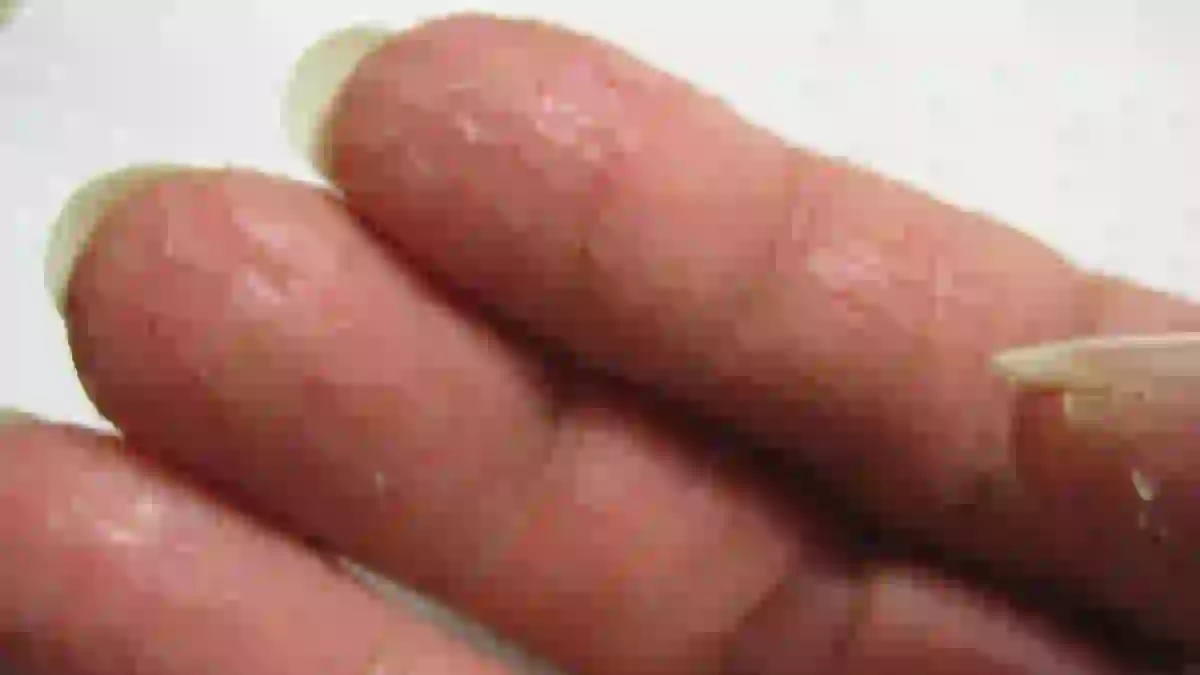
Cracks on fingers - Diabetes. An increase in normal blood sugar levels immediately affects the health of the skin on the hands and the dryness of the epidermis. Ulcers, cracks, and abscesses appear;
- Dermatological diseases. These include dermatitis in children, eczema, psoriasis;
- Allergic diseases. This is not only about the body’s reaction to an excess of vitamins. In winter, hypothermia often makes itself known by cracks and the appearance of red “nodules” on the fingers (not to be confused with gouty neoplasms as in the photo).
Sometimes these problems can be caused by calluses, chemical cleaners, or working with building materials.
Symptoms
It is necessary to distinguish between ordinary cracks and signals from the body about the presence of diseases. For example, deep, non-healing ulcers indicate diabetes; you should consult a doctor as soon as possible. It is very important to quickly notice an allergic reaction to detergents, otherwise you may develop dermatitis. Symptoms of an allergy to detergents:
- Dry fingers;
- Brittle nails;
- Severe itching between the fingers, peeling.
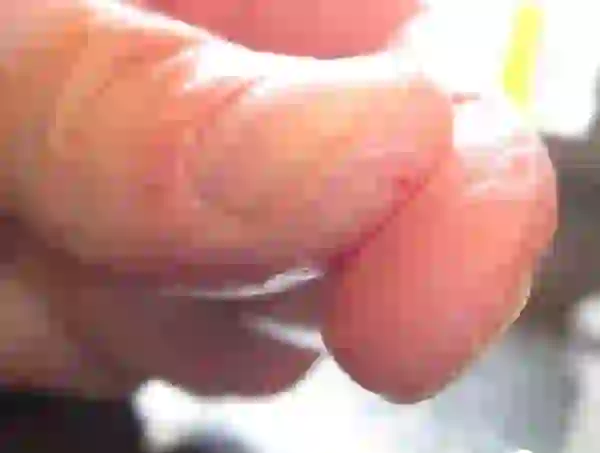
Photo - Cracks on fingers
Allergy to cold is a common occurrence in winter, but this fact does not make the disease any less dangerous than previous ones. This reaction can develop into a chronic phenomenon and occur even when washing dishes in cold water. What cracks on the fingers of women’s hands indicate this problem:
- Painful nodules on the pads;
- Cracks throughout the finger, especially on the phalanges;
- Dryness, itching, swelling of hands.
Sometimes bleeding ulcers appear from frost.
Video: why you need to wash your hands properly
Treatment
Traditional healers mainly use external medicines. It should be noted that if the causes of cracks in the fingers lie in diseases of the internal organs, then such a cure will not be effective.
Deep non-healing cracks in the skin of the fingers can be cured with a simple sunflower oil. You need to fill a metal bowl with enough oil to dip your fingers in. Then heat the liquid, stirring all the time. Please note that the oil heats up very quickly, you will need literally half a minute. If desired, add vitamins for the skin: A, E. You can buy them at the pharmacy. Do these baths every day until the oil cools down.
Excellent for treating redness and cracks between fingers salt bath. To prepare it, heat a pot of water, pour about 3 tablespoons of Dead Sea, Himalayan or at least iodized salt into it. Then drop a spoonful of essential oil, such as tea tree or castor oil, into the liquid and dip your fingers. Minerals will help heal wounds faster and restore skin.
Painful, weeping wounds on the fingertips, inflamed cracks will heal Oak bark. This folk remedy has an astringent effect and effectively heals wounds. Homeopathy also uses a decoction of this drug to treat stomatitis, periodontal disease, and fungal diseases. For a glass of water you need to take two tablespoons of oak bark. You need to bathe your hands and feet in the resulting solution for half an hour every day.
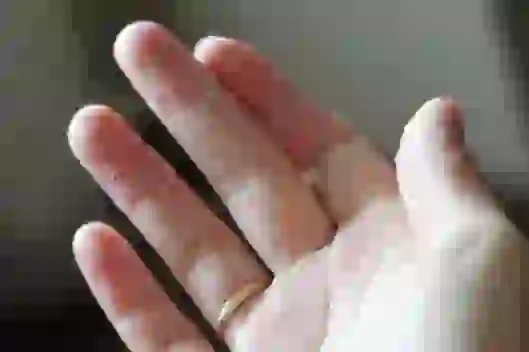
Photo - Your fingers will peel off
Often, treatment of cracks on the fingers and wounds on the phalanges is carried out using glycerin composition. This recipe is suitable if you are allergic to household chemicals. The recipe is as follows:
- Two fresh potatoes;
- Two parts milk;
- One part glycerin;
- A teaspoon of any essential oil.
Combine all the ingredients, mix thoroughly and lubricate your fingers with the resulting solution. Many recipes will be much more effective if you not only soak your hands in the resulting decoctions and mixtures, but also apply liquids in the form of a compress.
This can be done at night. Pre-wash your hands with moisturizing soap. Apply castor, olive or sunflower oil to clean hands, and put on cotton gloves on top. You need to do this every evening, then you will forever forget about the cracks on the phalanges or fingertips.
Helps against severe inflammation Birch tar. It should be applied to the wounds, left for half an hour and removed with paper napkins. Also, if cracks appear on the palms or bends of the fingers, Vishnevsky ointment helps well at home. It should be spread on clean hands and wounds, covered with gloves or towels until absorbed. In many cases, improvement occurs within two hours. Another remedy can be used if old wounds or scars become inflamed.
Removes dry cracks and calluses hernia remedy. You need to buy fresh herbs, chop it finely, combine it with olive oil in a ratio of 1:5. Then place in a dark place in a glass container. This remedy will help heal wounds on the thumbs and index fingers, remove peeling skin and itching. This ointment is considered an excellent cure for cracks in the bends of the hand and purulent wounds on the fingers.
Be sure to take your vitamins. This could be “Aevit”, “Vitrum”, “Multitabs” and others, which will help saturate the body with the necessary substances. Modern cosmetology also uses intradermal injections of vitamins.
Traditional methods will help cure only external manifestations. To identify and eliminate serious diseases, diagnosis is necessary. She will be able to show possible problems with blood vessels and joints. You should also definitely consult a dermatologist.
The appearance of painful cracks in the skin of the fingers is sometimes difficult to explain due to the lack of visible reasons. Their unattractive appearance is only half the story. Slowly healing and constantly bleeding wounds make it difficult to perform manual work, cause discomfort, and interfere with normal human life. To prevent the problem, it is important to know about the possible causes of its occurrence, as well as about current methods of treating cracks in the fingers, which will get rid of them in the shortest possible time and help avoid serious complications.
Causes of cracked fingers
Human skin serves as an excellent indicator indicating the state of health of the body. As soon as any malfunctions appear in its work, the epidermis is the first to react to them by sending signals. Cracks that form on the skin of the fingers can signal the development of certain diseases.
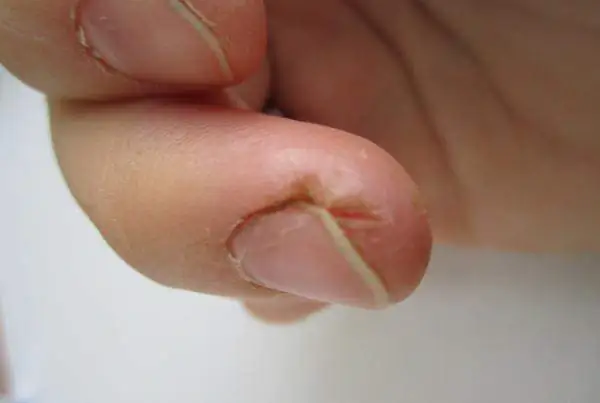
Fungus. Diseases caused by parasitic fungi destroy nails and damage the skin on the fingers, causing severe itching and peeling. As the disease progresses, it can lead to the appearance of deep wounds.
Diabetes. A systematic increase in blood sugar levels instantly affects the condition of the skin of the hands. Dryness appears, and as a result, cracks, ulcers, abscesses and gouty nodules.
Dermatological diseases. These include infantile dermatitis, eczema and psoriasis.
Avitaminosis. If there is a lack of vitamins in the body, the skin (particularly on the hands and face) begins to peel, becomes dry, and may crack.
Endocrine diseases. Malfunctions of the endocrine system can disrupt the skin metabolism process.
Unfavorable external factors such as:
- frequent skin contact with very cold or chlorinated water;
- exposure to household chemicals and other aggressive substances;
- cosmetics of questionable quality or expired;
- climatic conditions (frost, cold, wind, arid climate, temperature changes);
- prolonged exposure to direct sunlight.
Main places of crack formation
Cracks and wounds are localized on the bends of the fingers, in the folds of the palm and on the outside above the joints, on the pads of the fingers, near the nails (nail fold area), at the base of the phalanges of the fingers, and also between them.
The most vulnerable areas are the bends of the fingers. The slightest movement of the brush causes the skin in these places to stretch, and if it is very dry and tight, rupture may occur. The healing period for cracks in these places is quite long.
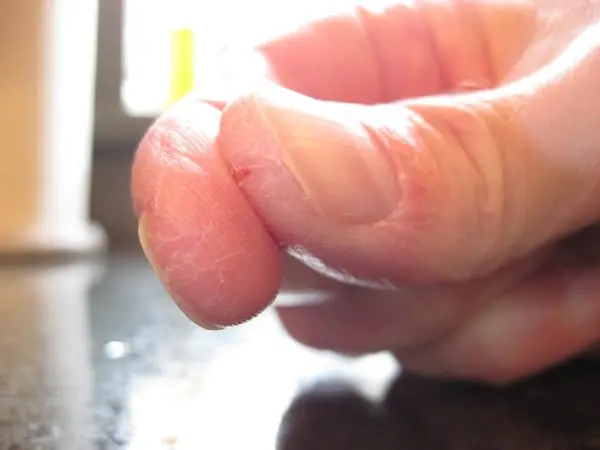
Calluses often form on the fingertips, which are replaced by cracks. Non-healing damage in this area is characteristic of an inflammatory disease such as eczema. Cracks between the toes are the first signs of palmoplantar psoriasis. And their appearance under the nails is most often associated with vitamin deficiency, eczema and the development of fungal diseases.
Drug treatment
Proper treatment for any disease guarantees a quick recovery. Therefore, before you begin to eliminate this or that problem, you should first find out the exact reasons that provoked this phenomenon. So, if you find cracks in the skin of your hands, you should immediately contact a dermatologist. The specialist prescribes, first of all, scraping the fingers to check the presence or absence of mycosis or mycelium. If the result is positive, antifungal therapy is prescribed.
You can get rid of shallow cracks using cosmetic creams and balms, which contain components with softening, moisturizing, anti-inflammatory properties and extracts of medicinal plants. For example, Green Pharmacy cream (with chamomile extract), Bioderma, Boro Plus (pink and green), Rylana, as well as silicone, spermaceti and lanolin creams. Among the balms we can highlight “Rescuer” and “Keeper”.
In case of complications, pharmaceutical ointments with a wound-healing effect are needed: ichthyol, calendula ointment, Vishnevsky ointment, Dexapanthenol. Pronounced deep cracks on the fingers can be healed faster with the help of medical glue “Sulfacrylate” and BF-6.
All medications must be prescribed by a doctor after a preliminary examination. Treatment of severe cases involves the prescription of drugs with a more powerful and broad spectrum of action.
Antiseptics (Chlorhexidine, hydrogen peroxide, Miramistin). Usually used in combination with wound healing agents and to prevent infection.
Antibacterial drugs. Use only in the presence of a bacterial infection.
Drugs to stimulate metabolism in tissues - Methyluracil, Actovegin, Radevit. It is not recommended to use on your own.
Corticosteroid ointments for the treatment of diseases such as dermatitis, eczema - Flucinar, Prednisolone ointment, Fluorocort, Celestoderm. For psoriasis, emulsions based on active substances are prescribed: aloe, tar, solid oil, amium.
Treatment with folk remedies
The influence of external irritants that contribute to the appearance of cracks can be, if not avoided, then reduced by following simple daily rules.
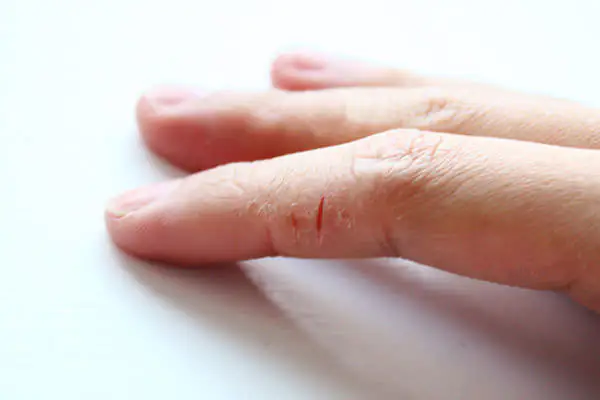
Use rubber gloves when your hands come into contact with household chemicals.
- Wash your hands with baby soap.
- Moisturize your hands daily to reduce the risk of cracking.
- If shallow cracks on the fingers do sometimes occur, they can be cured with the help of folk remedies prepared at home.
Potato broth. 1 tbsp. mix a spoonful of potato starch with 2 tbsp. spoons of vegetable oil and add 500 ml of water in which the potatoes were boiled. Place your hands in the broth for 13-15 minutes. Then wash and dry with a towel.
Milk-glycerin solution. Mix 200 ml of water with the same amount of milk, add 5-6 drops of glycerin and 1.5-2 tbsp. spoons of corn starch. Keep your hands in the solution for 7-10 minutes.
Cedar oil. Moisten a linen cloth measuring 30x30 cm in preheated cedar oil and wrap your hands in it. Unwrap after 30 minutes.
Cucumber compress. 1 fresh cucumber, peel and grate on a fine grater. Apply the paste to cracks or damaged areas.
Deep and constantly forming cracks on the fingers that cannot be treated with simple remedies must be shown to a specialist. Such skin lesions may be the result of an infection or fungus and therefore require special treatment. You should not self-medicate. It may not only be ineffective, but also cause serious complications and harm to health.
The skin is the most important organ that prevents infection by various infections and viruses. Contact with poor quality water, aggressive substances, prolonged exposure to cold and many other factors provoke cracks in the fingers. In addition to its unpleasant appearance, the disease causes severe pain and itching. The problem often signals the development of diseases that need treatment. In this case, you need to undergo a full diagnosis from specialists to identify the failure.
Causes of defects on the skin of the hands
It is strongly recommended to find out why cracks appeared on your hands and what could have caused them. Most often, dryness can be noticed after contact with aggressive substances during cleaning or prolonged exposure to the street in frosty weather. Provoking factors are:
- Working with aggressive substances. Prolonged exposure of the dermis to paint, laundry detergent, detergent or alkaline soap causes irritation. After some time, red spots, peeling and even wounds appear on the hands.
- Neglecting hand care. In late autumn, winter and early spring, you should use a moisturizer, since exposure to wind or frost causes the protective film on the surface to become thinner. Nourishing cream for cracked fingers will provide additional protection and maintain the elasticity of the epidermis.
- Mechanical injuries. Frequent finger injuries in people who regularly work with cutting objects cause changes in the structure of the skin. Over time, the cuts do not heal completely and small scars and cracks form.
- Working with the earth. “Gardener’s hands” - the problem appears in adults who come into contact with the ground without using gloves. Often, rough, dry skin with small cuts can be noticed in spring and autumn. The same factor includes hard water, which also negatively affects the appearance of your hands.
- Poor nutrition or lack of vitamins. Diets and fasting cause a lack of useful elements in the body. For rapid cell regeneration, vitamins A, E, B7, as well as magnesium are required. If they are missing, then the epidermis throughout the body becomes sensitive and vulnerable to any injury.
What to do if none of the provoking factors could cause the defect? In this case, you need to think about possible internal violations. Many diseases are characterized by cracking of the skin. It is worth thinking about the following pathologies:
- Thyroid diseases. Improper metabolism causes disturbances in the functioning of many internal organs. Diabetics may notice poor condition of hair, nails and skin. Wounds and cracks on the fingers often do not heal for a long time, forming ulcers, which can be seen in the photo. The most common diseases are diabetes and hypothyroidism.
- Infectious or non-infectious skin diseases. This group includes fungal or viral infections, as well as psoriasis and eczema. Often the diseases cause cracking and peeling of the dermis with severe itching or rashes on the body. Deep cracks in the fingers form near the nails or on the sides, do not heal for a long time and cause severe pain.
- Infection of the body with parasites. The main signs are abdominal pain, decreased appetite and weight loss. Worms not only take away all the useful microelements, but also poison the body of an adult or child with the decay products of their vital activity. As a result, you may notice dry skin, cracks in the palms and fingers, as well as allergic rashes.
- Chronic diseases of the gastrointestinal tract or nervous system. Disturbances in the functioning of these systems lead to a decrease in immunity, which means the general condition of the body worsens. For this reason, various damage to the surface of the body and frequent illnesses are noticeable.
In addition, ichthyosis and Reiter's syndrome can affect the appearance of the hands. The first will be indicated by rough skin, similar to scales, which cracks when pressed. The disease can be congenital or acquired. The peak incidence is diagnosed in winter. Reiter's syndrome manifests itself in damage to the genitourinary, skeletal and muscular systems, as well as the mucous membranes and epidermis. Rashes, thickened skin, dryness and cracks are noticeable on the extremities.
Danger of illness
Inflammation of the joints of the fingers
Inflammation of the phalanx of the finger not only indicates the development of serious diseases, but is also considered a dangerous phenomenon. Pathogenic bacteria or infections easily penetrate through damage in the dermis, causing suppuration and inflammatory processes in the tissues. As a result, a fungal disease of smooth skin or nails develops. Painful cracks in the skin of the fingers prevent you from doing any work normally. If the wounds are not healed in time, then over time a new failure may occur in the weakened body and cause destruction of the nail plates. In addition, it is possible to develop felon, an acute disease that affects the soft tissues of the fingers. Causes severe pain and purulent processes.
Localization of damage and symptoms
You can notice painful lesions everywhere. They occur on the folds of the outer or inner side of the palm, near the knuckles and nails, on the pads or between the fingers on the dermis. All injuries cause discomfort when moving your hands or coming into contact with water.
A person feels the greatest discomfort if peeling skin on the fingers has formed in the folds or on the pads. Even light contact with any object causes burning and itching due to stretching of the epidermis. Inadequate treatment of pathology worsens the structure of the skin, making it dry and thin. For this reason, breaks do not heal for a long time, but only increase in size. Calluses often appear on the pads, which are followed by cracking. Prolonged inflammation can signal the onset of eczema or diabetes. With psoriasis, cracks mainly appear on the arms and legs.
Damage on the fingers near the nails and under them indicates a lack of vitamins A, E, and B, as well as fungal infection of the tissues. Cracking or convergence of the nail plate, suppuration and change in skin tone are diagnosed. Vitamin deficiency does not cause pain, redness or itching. You only feel roughness, dryness of the hands and cracking of the dermis. An allergic reaction manifests itself in itching, burning and swelling. Healthy, elastic skin can change to rough skin after prolonged contact with water, dust or soil.
Non-bleeding cracks on the fingertips are a negative result of long-term therapy with antibiotics or hormonal agents. The occurrence of symptoms such as the discharge of blood or pus, severe itching, deep cracks and changes in skin color indicate diseases of the internal organs. You should definitely visit an endocrinologist, surgeon or dermatologist to identify the cause of the damage.
Treatment options
It is highly undesirable to resort to medications without consulting a specialist. Before contacting a doctor, you can only use moisturizers: nourishing cream, essential oil or Vaseline. Self-administration of medications will relieve symptoms and the examination results will be unreliable. In addition, the wrong drug often provokes deterioration.
For creams for healing cracked hands, it is recommended to use cosmetic products without alcohol and artificial moisturizers. The most effective natural substances are lanolin, essential oils of jojoba, coconut, sea buckthorn, shea or tea tree. Examples of creams: Bioderma, Rilana, Newtrogina, Dachnitsa and Biocon. Among pharmaceutical products, Bepanten, Panthenol, Solcoseryl ointment and Apilak will have a therapeutic effect on small wounds.
The famous Vishnevsky ointment helps with burns, purulent wounds and cracks on the body. You should not refuse the product because of the unpleasant odor, as it really helps relieve inflammation and restore the dermis. It should be applied several times a day to the affected areas. Ichthyol ointment, Levomekol and Dexpanthenol have similar effects. Boro Plus cream in pink or green packaging has a more neutral scent. You will have to use it to heal cracks on your hands 3-4 times a day, since the product is well absorbed and quickly washed off with water.
For diseases of the internal organs, certain medications are prescribed for a particular disorder. For example, Radevit, Actovegin or Methyluracil are used to stimulate metabolism. Fungal infections of nails and skin are treated with antimycotic drugs in the form of ointments or tablets. It is recommended to choose Clotrimazole or Pimafucin, as they do not cause side effects and have a wide spectrum of action. It is possible to alleviate the condition of eczema and psoriasis by using ointments based on Prednisolone.
Cracks on the fingers near the nails that are caused by an allergic reaction should be treated with antihistamines. It is necessary to exclude even minimal contact with the irritant. To relieve itching, burning and swelling, internal tablets are prescribed - Loratadine, Suprastin or Cetirizine. In addition, it is allowed to smear the affected areas with Psilo-balm.
How to do without the help of a doctor
How to treat cracks in fingers without specialist advice? Sometimes it happens that it is not possible to visit a doctor at the moment. It’s easy to alleviate the condition, learn about simple remedies. BF-6 medical glue will help seal deep wounds. It is absolutely safe and does not cause suppuration or allergies. The product can only be used to treat dry skin without pus or blood. A small amount of glue is applied to the crack and wait a few minutes, during which it dries. Cracks heal faster, since their edges are fixed and do not diverge further. In addition, no water or pollution gets into them, which also speeds up recovery. From time to time, damage to the finger is glued, if necessary. After such therapy, it is recommended to apply a moisturizer.
Sulfacrylate has a similar effect. It is applied to the affected areas, dries and forms an invisible film. It needs to be applied more often than medical glue, but the drug also has a healing effect. Its composition ensures the destruction of pathogenic organisms and relieves inflammation.
It is also possible to resort to traditional medicines, which are easy to prepare at home. An effective remedy is a homemade ointment made from glycerin, water, honey and flour. You need to mix 2 tablespoons of glycerin and water, and then add a spoonful of honey and flour. The resulting mixture is applied to sore fingers at night, and cotton gloves should be worn on top. In the morning, hands are washed under water and treated with moisturizer.
Wound healing ointment from celandine will ensure the destruction of bacteria and heal the damage. Three tablespoons of dry herb are diluted with a glass of vegetable oil and boiled for 2–3 minutes. Next, add 20 grams of beeswax, heat it and pour it into a container with a lid. After cooling, apply the product to sore fingers several times a day. It is recommended to store it in the refrigerator.
A lemon bath with vitamin A and E will help restore damaged epidermis. Squeeze the juice out of one lemon, add 2 tablespoons of olive oil and a few drops of vitamins A and E (capsules are sold in pharmacies). The mixture is stirred and heated in a water bath to a temperature at which you can hold your hands without discomfort. Place your fingers in a warm bath for 10–15 minutes. After the procedure, it is important not to rinse the skin under water, but only blot it with a dry cloth.
These methods should not be used to treat painful cracks in the fingertips that ooze blood, pus, or other fluid! This is a signal of an inflammatory process, so you should definitely contact a dermatologist to undergo the necessary tests.



